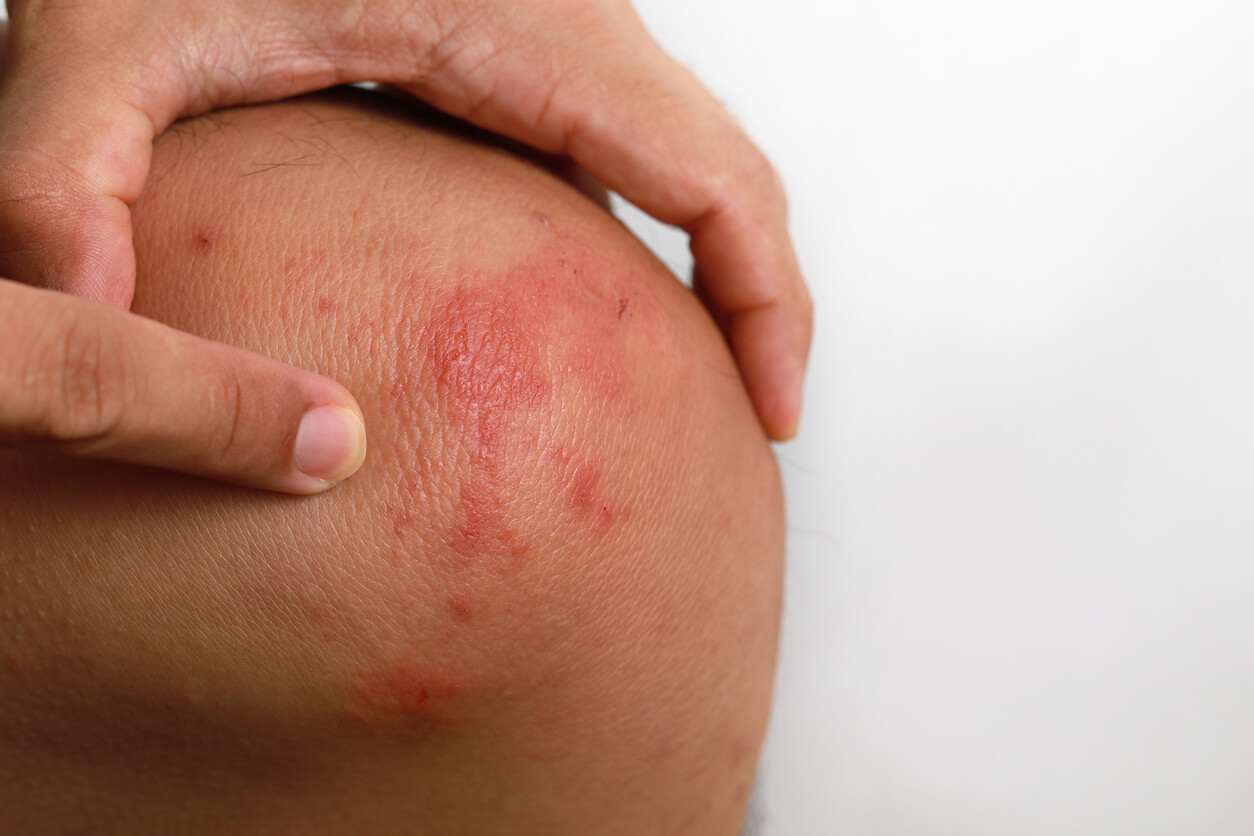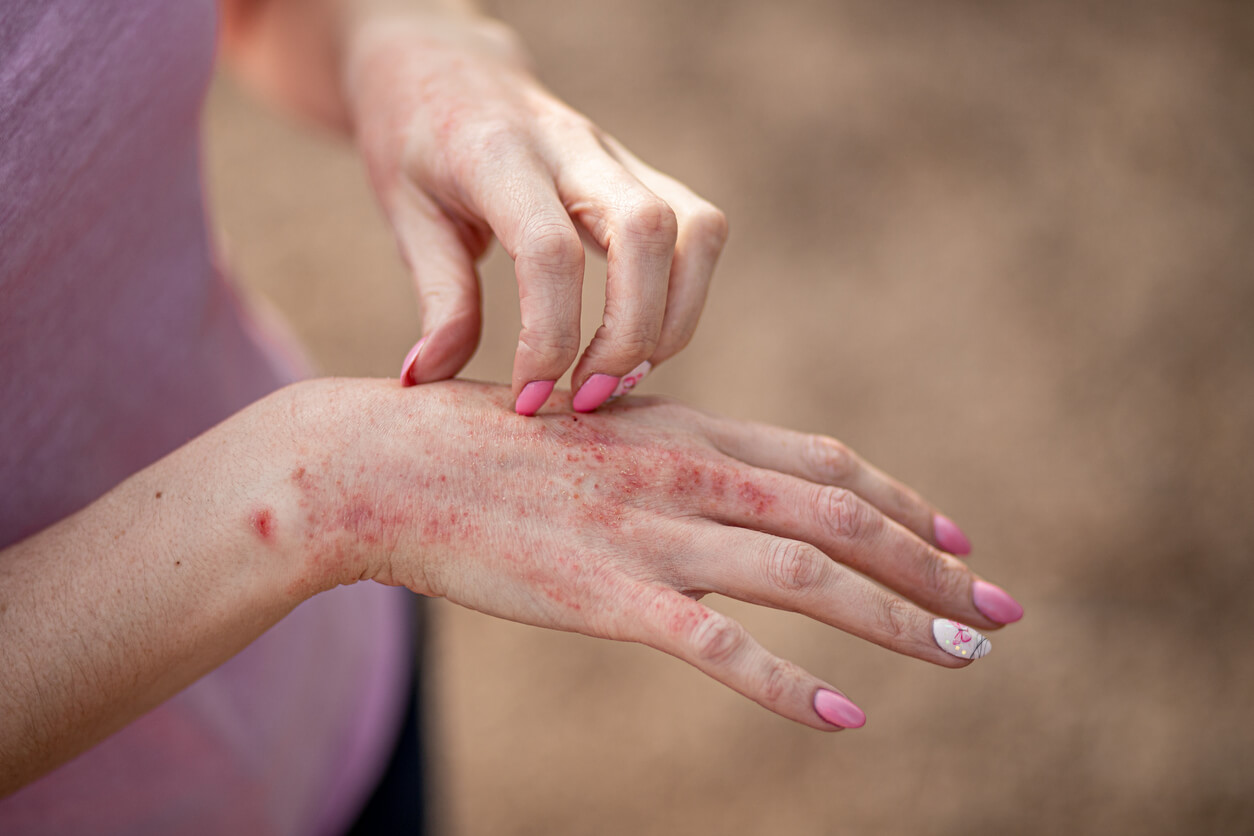Psoriasis During Pregnancy: What You Should Know


Written and verified by the dermatologist Maria del Carmen Hernandez
Most pregnant women experience an improvement in their psoriasis. However, exacerbation of symptoms may also occur. In addition, in many cases, depression may develop because the quality of life is often poor. Here’s everything you need to know about psoriasis during pregnancy.
What is psoriasis?
Psoriasis is a chronic, systemic, inflammatory disease characterized by the presence of typical lesions on the skin. In fact, it affects 2.5% of the general population. This disease is associated with several comorbidities that the person presents:
- Depression
- Inflammatory bowel diseases
- Cardiovascular diseases
- Metabolic syndrome
- Psoriatic arthritis
It’s a disease that has a significant psychological and physical burden with a negative impact on the quality of life of the sufferer. In addition, the health of the mother and baby must be taken into account when managing psoriasis during pregnancy.
The symptoms of psoriasis during pregnancy

The first manifestations of psoriasis usually appear between the second and fourth decade of life. Therefore, the onset of the disease coincides with the reproductive years of women. In addition, significant endocrine and immune changes occur during pregnancy, which can lead to exacerbation of the disease.
The classification of psoriasis
Psoriasis is classified into two types:
- Type 1: Has a positive family history and begins before the age of 40.
- Type 2: No family history and presents after the age of 40.
You may be interested in: Hair and skin changes during pregnancy
What does the diagnosis of psoriasis involve?
The diagnosis of psoriasis is based on the woman’s clinical presentation and doesn’t usually require a biopsy. The plaques can be itchy and painful. In fact, when the scale is removed by scraping, fine bleeding spots, called Auspitz’s sign, can be observed.
Some diagnostic investigations are the involvement of the periumbilical region, nails, and buttocks. Differential diagnoses that can be considered are the following:
- Atopic dermatitis
- Pityriasis rosea
- Tinea corporis
- Contact dermatitis
- Lichen planus
- Secondary syphilis
- Mycosis fungoides

The management of psoriasis during pregnancy
The first trimester of pregnancy is the period with the highest likelihood of drug-induced teratogenicity. Therefore, psoriasis should be controlled or in remission prior to conception to minimize potential flares during gestation.
Topical therapies
The first-line treatment of psoriasis during pregnancy is topically administered medications. Consequently, systemic levels won’t become high enough to cause adverse effects on the baby. In addition, in limited psoriasis, moisturizers and emollients should be the option of choice, as they don’t produce significant adverse results and are well tolerated.
Topical corticosteroids are safe for pregnant women when used appropriately:
- With the lowest potency
- Judicious control of the duration
- Amount of application
Phototherapy
Narrowband UVB is considered a first-line treatment when a systemic approach is needed. According to studies in the Journal of the American Academy of Dermatolgy, no premature births or fetal abnormalities were associated with this treatment.
During the UVB procedure, sunscreen should be applied to the face to avoid the development of melasma (a common condition in pregnant women where brown spots appear on the skin). In addition, folic acid levels should be monitored along with proper vitamin supplementation.
Oral systemic therapies that aren’t allowed
Methotrexate is an FDA Category X drug. It’s contraindicated during pregnancy, as it has been shown to be abortifacient, mutagenic, and teratogenic.
Acitretin is a second-generation retinoid with a high teratogenic risk, mainly during the first trimester of pregnancy. Cyclosporine can cross the placental blood barrier and reach values in the baby’s circulation of up to 50% of the maternal plasma concentration.
Psoriasis during pregnancy
Psoriasis can profoundly affect people’s mental health and quality of life, with an even higher burden for pregnant women. In turn, the onset of the condition often coincides with the peak reproductive years for women, which limits therapeutic action. However, this disease doesn’t affect a woman’s ability to become pregnant and isn’t associated with miscarriage or birth defects.
Most pregnant women experience an improvement in their psoriasis. However, exacerbation of symptoms may also occur. In addition, in many cases, depression may develop because the quality of life is often poor. Here’s everything you need to know about psoriasis during pregnancy.
What is psoriasis?
Psoriasis is a chronic, systemic, inflammatory disease characterized by the presence of typical lesions on the skin. In fact, it affects 2.5% of the general population. This disease is associated with several comorbidities that the person presents:
- Depression
- Inflammatory bowel diseases
- Cardiovascular diseases
- Metabolic syndrome
- Psoriatic arthritis
It’s a disease that has a significant psychological and physical burden with a negative impact on the quality of life of the sufferer. In addition, the health of the mother and baby must be taken into account when managing psoriasis during pregnancy.
The symptoms of psoriasis during pregnancy

The first manifestations of psoriasis usually appear between the second and fourth decade of life. Therefore, the onset of the disease coincides with the reproductive years of women. In addition, significant endocrine and immune changes occur during pregnancy, which can lead to exacerbation of the disease.
The classification of psoriasis
Psoriasis is classified into two types:
- Type 1: Has a positive family history and begins before the age of 40.
- Type 2: No family history and presents after the age of 40.
You may be interested in: Hair and skin changes during pregnancy
What does the diagnosis of psoriasis involve?
The diagnosis of psoriasis is based on the woman’s clinical presentation and doesn’t usually require a biopsy. The plaques can be itchy and painful. In fact, when the scale is removed by scraping, fine bleeding spots, called Auspitz’s sign, can be observed.
Some diagnostic investigations are the involvement of the periumbilical region, nails, and buttocks. Differential diagnoses that can be considered are the following:
- Atopic dermatitis
- Pityriasis rosea
- Tinea corporis
- Contact dermatitis
- Lichen planus
- Secondary syphilis
- Mycosis fungoides

The management of psoriasis during pregnancy
The first trimester of pregnancy is the period with the highest likelihood of drug-induced teratogenicity. Therefore, psoriasis should be controlled or in remission prior to conception to minimize potential flares during gestation.
Topical therapies
The first-line treatment of psoriasis during pregnancy is topically administered medications. Consequently, systemic levels won’t become high enough to cause adverse effects on the baby. In addition, in limited psoriasis, moisturizers and emollients should be the option of choice, as they don’t produce significant adverse results and are well tolerated.
Topical corticosteroids are safe for pregnant women when used appropriately:
- With the lowest potency
- Judicious control of the duration
- Amount of application
Phototherapy
Narrowband UVB is considered a first-line treatment when a systemic approach is needed. According to studies in the Journal of the American Academy of Dermatolgy, no premature births or fetal abnormalities were associated with this treatment.
During the UVB procedure, sunscreen should be applied to the face to avoid the development of melasma (a common condition in pregnant women where brown spots appear on the skin). In addition, folic acid levels should be monitored along with proper vitamin supplementation.
Oral systemic therapies that aren’t allowed
Methotrexate is an FDA Category X drug. It’s contraindicated during pregnancy, as it has been shown to be abortifacient, mutagenic, and teratogenic.
Acitretin is a second-generation retinoid with a high teratogenic risk, mainly during the first trimester of pregnancy. Cyclosporine can cross the placental blood barrier and reach values in the baby’s circulation of up to 50% of the maternal plasma concentration.
Psoriasis during pregnancy
Psoriasis can profoundly affect people’s mental health and quality of life, with an even higher burden for pregnant women. In turn, the onset of the condition often coincides with the peak reproductive years for women, which limits therapeutic action. However, this disease doesn’t affect a woman’s ability to become pregnant and isn’t associated with miscarriage or birth defects.
All cited sources were thoroughly reviewed by our team to ensure their quality, reliability, currency, and validity. The bibliography of this article was considered reliable and of academic or scientific accuracy.
- Greb JE, Goldminz AM, Elder JT, Lebwohl MG, Gladman DD, Wu JJ, Mehta NN, Finlay AY, Gottlieb AB. Psoriasis. Nat Rev Dis Primers. 2016 Nov 24;2:16082. doi: 10.1038/nrdp.2016.82. PMID: 27883001
- Chi CC, Wang SH, Wojnarowska F, Kirtschig G, Davies E, Bennett C. Safety of topical corticosteroids in pregnancy. Cochrane Database Syst Rev. 2015 Oct 26;(10):CD007346. doi: 10.1002/14651858.CD007346.pub3. PMID: 26497573.
- Menter A, Korman NJ, Elmets CA, Feldman SR, Gelfand JM, Gordon KB, Gottlieb A, Koo JYM, Lebwohl M, Lim HW, Van Voorhees AS, Beutner KR, Bhushan R. Guidelines of care for the management of psoriasis and psoriatic arthritis: Section 5. Guidelines of care for the treatment of psoriasis with phototherapy and photochemotherapy. J Am Acad Dermatol. 2010 Jan;62(1):114-135. doi: 10.1016/j.jaad.2009.08.026. Epub 2009 Oct 7. Erratum in: J Am Acad Dermatol. 2021 Feb;84(2):586. PMID: 19811850.
- Petri M. Immunosuppressive drug use in pregnancy. Autoimmunity. 2003 Feb;36(1):51-6. doi: 10.1080/0891693031000067296. PMID: 12765471.
- Nair PA, Badri T. Psoriasis. 2020 Nov 20. In: StatPearls [Internet]. Treasure Island (FL): StatPearls Publishing; 2021 Jan–. PMID: 28846344.
This text is provided for informational purposes only and does not replace consultation with a professional. If in doubt, consult your specialist.








